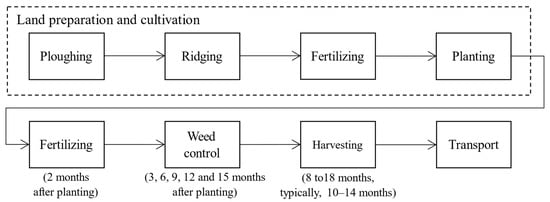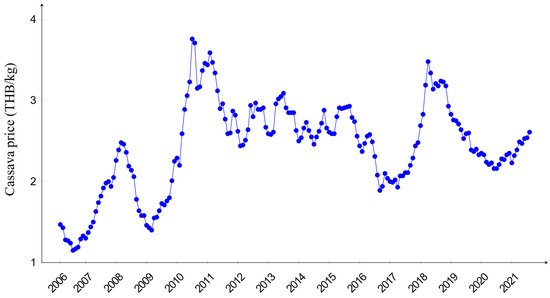You're using an outdated browser. Please upgrade to a modern browser for the best experience.
Please note this is a comparison between Version 1 by Parthana Parthanadee and Version 2 by Rita Xu.
Cassava harvest practices and choose a pricing scheme between farmers and factories, cassava yards, and collectors in Thailand. Harvest practices represent all activities from land preparation to harvest.
- cassava
- harvesting age
- pricing scheme
1. Introduction
Cassava is an important economic crop of Thailand. In 2020, Thailand’s cassava production amount (29 million tons) was at the third rank in the world [1]. Thailand cassava export, in the forms of cassava dried (chips and pellets) and cassava starches, was ranked first with approximately 57% of global market share due to relatively much lower domestic consumption [2]. The total export volumes had ever been around 11 million tons from 2014 to 2017 but have been decreasing since 2018 and were at 7.14 million tons in 2020 [3]. However, unlike most developed countries, where agricultural products are produced in large farms under contract farming with the buyers, there are a large number of small-sized cassava farms in Thailand, mostly without contract farming. In 2020, there were 587,754 cassava farming households with an average farm size of 2.57 hectares [4].
In general, fresh cassava root production (Figure 1) consists of the following activities: land preparation and cultivation, fertilizing, weed control, harvesting, and transportation. First, the land is ploughed at least once prior to ridging. Then, organic fertilizers, e.g., compost and chicken manure, are added, and stems are planted. After two months, fertilizer, usually a chemical type, is applied to enhance nutrients in the soil. Then, weed control is performed every three months, either by using herbicide or manual removal by human workers in order to protect the cassava stems from weeds. Finally, the cassava is harvested and transported to a cassava yard or starch factory.

Figure 1. Typical cassava production process in Thailand.
Factors that directly affect farmers’ profit from selling their harvests include the cost of cultivation activities that is directly driven by the harvesting age, yield (amount and starch content, expressed as a percentage), market price, and the pricing basis in which to sell the products to local buyers, defined as “pricing scheme” in this paper. Among these factors, market price and yield, to a lesser degree, are not under the farmers’ control. Although cultivation activities can affect yield, there are other uncontrollable external factors related to climate change, such as amounts of rainfall, drought, flood, pest and disease breakouts. Cassava yield also changes with harvesting age. Naturally, cassava root’s weight increases, while starch content tends to decrease, as cassava grows older. In addition, there is a relationship between the decrease in starch content and high rainfall during the harvesting period, as the cassava plant reinitiates its growth and creates new sprouts, and translocate the nutrients from the root to the top of the plant [5][6][7][5,6,7].
Since most Thai farmers perform common cultivation activities, the two important factors under farmers’ control that affect cost, revenue, and thus, profitability are the length of harvesting practices and pricing scheme. The amount of resources required for cassava’s harvesting practices is driven primarily by its harvesting age. The harvesting age can range from eight months (the earliest age that cassava is harvested) to 18 months (the oldest age of cassava sold in the market). Moreover, there is some variation in the length of harvesting practices that farmers prefer. Harvesting practices length may be fixed or varying within an interval. The most common practice among Thai farmers is to harvest once a year, i.e., a fixed harvest cycle of 12 months. However, some farmers consider market price when making their harvest timing decision. In other words, the market price trend directly affects the likelihood of harvesting, as farmers prefer to harvest when the market price is high, or they may postpone harvesting when the market price is low. This leads to harvesting practices with some variations in its length. For example, a 10-month to 14-month varying length implies that most farmers may harvest their cassavas as early as 10 months, or as late as 14 months after planting.
After harvesting, farmers have to choose where to sell their produce, based on factory-gate buying prices and pricing schemes. In Thailand, there are two pricing schemes: weight-based and starch-content-based. Weight-based pricing is widely used by collectors, cassava chip manufacturers, and some starch manufacturers, while the starch-content-based pricing is mainly used at starch manufacturers. With weight-based pricing, the harvest is sold according to the weight (in tons) only; whereas with starch-content-based pricing, the quality of the harvest is evaluated at the factory gate to determine the percentage of starch content and the per-kilogram buying price. The market price is quoted at a level of starch content, either at 30%, or 25%. When the cassava has lower starch content, the buyer decreases the buying price, depending on the measured starch content of the harvest. Usually, in a particular area, the quoted market price at 30% starch content is higher than the market price of the weight-based pricing.
As a commodity product, changes in cassava supply and market demand lead to price fluctuation. In the past decade, the market trend is somewhat positive due to increasing demand from emerging market (China) that uses cassava as raw material for producing alternative energy, i.e., biodiesel. In recent years, some influential events and factors, e.g., an outbreak of diseases, climate change, world economy, technological change, government policies, contribute to higher uncertainty in the demand and supply of cassava, which highly affects cassava market prices. Figure 2 illustrates the market price of cassava over the past decade. It can be seen that the price fluctuates in an unpredictable manner, i.e., the price pattern does not necessarily repeat itself from season to season. Making decisions under such volatile market situations to achieve economic sustainability is clearly a challenge for farmers.

Thai cassava farmers usually choose the time to harvest and pricing scheme based on their experiences, financial needs, and market price, without proper guidelines on choosing the harvesting age and pricing scheme. This may not lead to optimal and/or robust decisions. Thus, the objective of this paper is to provide a guideline for choosing harvesting age and pricing scheme, while considering uncertainties regarding other factors including market price, amount of resources required, its cost, yield amount and percent starch that change with age, through the use of a computer simulation model.
Simulation modelling is a methodology that can be used to analyze such an agricultural system that contains various sources of uncertainty. A simulation model imitates the real system with a logical/mathematical, computerized model. The major benefit of using simulation is that the system behavior can be studied through computational experiment in advance without disrupting the real system. AIn this paper, a simulation model is developed to imitate cassava production processes under uncertainties. Using the model, farmers’ decision makings regarding the harvesting age and pricing scheme are analyzed under volatile market scenarios so as to maximize the economic benefit, i.e., profit, for the farmers. It is important to emphasize that the harvesting age governs the farming activities and resources required until harvest. Therefore, from this perspective, the harvesting age essentially represents the harvesting practices. Input data of the model are from an extensive survey study using face-to-face interviews with the farmers. After constructing the model, model verification and validation are properly performed to ensure that the model is a good representative of the real system. In addition, clustering analysis on market price is performed to identify common price scenarios that farmers may face. Different harvesting age and pricing scheme decisions are then tested under these market price scenarios in order to determine not only the optimal decisions that maximize profit, but also to obtain robust decisions. Analysis of the computational experiment results lead to the guideline for farmers to choose a harvesting age and a pricing scheme that maximize their average monthly profit. The guideline is based on a comparison between the market price posted at factory gate and the actual purchase price the farmer will receive based on the estimated starch content of their cassava roots.
